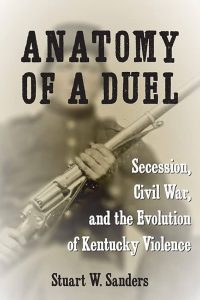Book Review: Anatomy of a Duel: Secession, Civil War, and the Evolution of Kentucky Violence

 Anatomy of a Duel: Secession, Civil War, and the Evolution of Kentucky Violence. By Stuart W. Sanders. Lexington: University Press of Kentucky, 2023. Paperback, 255 pp. $30.00.
Anatomy of a Duel: Secession, Civil War, and the Evolution of Kentucky Violence. By Stuart W. Sanders. Lexington: University Press of Kentucky, 2023. Paperback, 255 pp. $30.00.
Reviewed by Caroline Davis
The Commonwealth of Kentucky proved to be quite an enigma during the first half of the 19th Century. Although it was the fifteenth stated added to the Union, it was also the nation’s first “western” state. A major player in national politics—producing notables like Henry Clay, Richard Mentor Johnson, John J. Crittenden, and John C. Breckinridge—the Bluegrass State was seemingly both progressive and conservative in the decades leading up to the Civil War. Not unlike many states, the pre-war years were a period of constant change for Kentucky. However, the Civil War exposed numerous latent social and political issues that brought about a sea change of events during the four years of conflict and the decades immediately following the war that few Kentuckians could have imagined in 1860.
Captivatingly written, author Stuart W. Sanders, explores the many political, cultural, and social landscapes of Kentucky in his book Anatomy of a Duel: Secession, Civil War, and the Evolution of Kentucky Violence.
From the beginning of the Civil War, Kentucky became an important battle ground. With its significant geographical position, a wealth of resources, and a white population divided in its sympathies for the opposing sides, the commonwealth endured a game of “tug-of-war” of sorts.
As the United States military attempted to establish its dominance in the contested border state, some individuals suspected of holding Confederate sympathies came under arrest. As more and more arrests occurred, tensions grew. Many Kentuckians wished to remain neutral during the conflict, but it soon became clear that neutrality was futile. Sanders writes: “Kentucky’s neutrality had been a three- month shadow, a naïve, paper-thin wisp of hope that collapsed under internal and external pressure” (28). It was within this collapse of Kentucky’s neutrality and the arrests of the state’s citizens that a smaller, but ever still important conflict was born.
The idea of masculine honor was prevalent throughout the 19th Century United States, but particularly so in the slaveholding states. Though the use of dueling to settle arguments had dwindled by 1860, the need to defend oneself and one’s reputation remained a powerful influence. Sanders uses a Kentucky duel as the basis of his study.
Pro-Confederate politician William T. Casto was highly insulted when Union Col. Leonidas Metcalfe arrested him under orders from Gen. William “Bull” Nelson. Interestingly, all three men were Kentuckians. Casto felt further affront due to his incarceration at faraway Camp Chase in Ohio, rather than at a local jail. This, he believed was unjustified, as he, through self-proclamation, had not done anything illegal that would merit arrest and imprisonment. As such, upon his eventual release, Casto felt the need to seek redress for the wrongs he was dealt. Directing his ire at Metcalf and drawing on an age old “honorable” tradition, Casto challenged the colonel to a duel.
Anatomy of a Duel provides not only an interesting historical narrative, but also contributes to a sociological history of violence in America. Looking at the role of honor and masculinity in southern culture, Sanders takes the opportunity to delve deep into the topic and its overall impact on political events and the social structure of the 19th Century.
At times the narrative becomes repetitive, and the timeline can be difficult to follow without a decent understanding of the events discussed within the overall account. Nevertheless, Sanders does an excellent job of providing a well-reasoned, inclusive, and thorough interpretation of the events for the readers. With an excellent use of available primary and secondary source material, the research is both comprehensive and well documented.
Using the Civil War as its backdrop, Sanders weaves the narrative of the 1862 Casto-Metcalf duel with the event’s significance. Diving into this microhistory provides an interesting and expansive narrative of a small, nearly forgotten event on the banks of the Ohio River, while also connecting and highlighting the complexity of Civil War Kentucky.